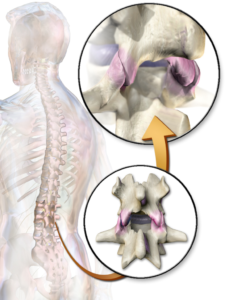Testing & Diagnostic Procedures : Lumbar Medial Branch Blocks (MBB)
Background:
The zygapophysial joints are small joints between the bones that make up the spine. These “z- joints” may become a cause of chronic low back pain. The only way to determine if these joints are the cause of your pain is to numb or “block” the nerves-called the medial branches- that send pain signals from the joints. If the medial branch block (MBB) eliminates your pain, then the joint is determined to be the cause of your pain. If your pain is not stopped by the block, then causes other than the z-joint may need to be considered. The MBB is a diagnostic test just like a chest x-ray, NOT a treatment. Therefore, you should not expect lasting pain relief from the MBB.
Precautions:
The MBB requires use of x-ray to precisely place the needle. Therefore, if you are pregnant, please inform your physician prior to the procedure. The amount of x-ray exposure is within recommended safe limits for adults, but can be hazardous to the developing fetus.
If you are on blood thinners or anticoagulants, please notify your physician. Special precautions or medication adjustments may be deemed necessary. However, do not stop your medication without consulting with your physician.
You will require a driver after the procedure as it may be unsafe to operate a vehicle.
Notify your physician of any allergies you may have.
Before the procedure:
You must have your usual pain (greater than 4 on a pain scale of 0-10) prior to the MBB to determine if the block stops your pain. Do not take your pain medication that day if it will make your pain less than 4 out of 10. Prior to the block, a record of your pain severity and location will be made. Rarely is sedation required.
During the procedure:
You will be placed onto a special table for the procedure. After cleansing the skin, a small needle will be directed precisely to the target nerve branch. Contrast dye followed by numbing medication-also called local anesthetic- is injected to ensure the target nerve is successfully blocked. Two or more injections will be done as determined prior to the procedure. There is generally a brief duration of minimal discomfort during the procedure. If you become lightheaded during the procedure, let your physician know.
After the procedure:
Your skin will be cleansed and a bandage applied as necessary. You will be taken to an observation area and monitored for any adverse reactions which are very rare. Your usual pain will be re-assessed and documented. You will be given a pain diary to further document your pain upon discharge from the center. It is extremely important for your treatment that you complete and return the pain diary.
Side effects or complications:
Side effects are generally minimal and can include increased discomfort, local bruising, headache, nausea, fainting or dizziness. These symptoms are usually short-lived and will resolve themselves. More severe complications are rare such as infection, allergic reaction, or nerve injury.
If you have any questions or concerns, please contact us at (610) 954-9400.


